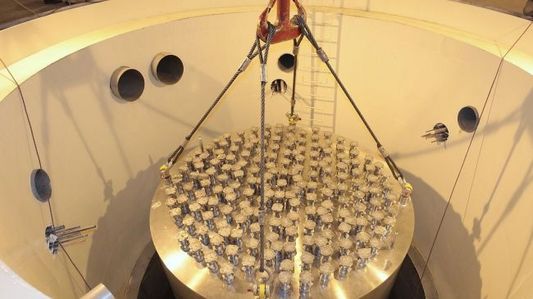 This issue of Science and Global Security brings together three contributions related to the production, safeguarding and origin attribution of plutonium. These articles are made important by the fact that only kilogram quantities of plutonium are required to make a simple nuclear weapon. For example, the world's first nuclear weapon, known as the "gadget" and tested on 16 July 1945 as part of the U.S. Manhattan Project, contained only 6 kg of plutonium in its core. It is known that advanced devices could use less.
This issue of Science and Global Security brings together three contributions related to the production, safeguarding and origin attribution of plutonium. These articles are made important by the fact that only kilogram quantities of plutonium are required to make a simple nuclear weapon. For example, the world's first nuclear weapon, known as the "gadget" and tested on 16 July 1945 as part of the U.S. Manhattan Project, contained only 6 kg of plutonium in its core. It is known that advanced devices could use less.
In "A Conversion Proposal for Iran's IR-40 Reactor with Reduced Plutonium Production," (Free PDF) Ali Ahmad and Alexander Glaser model plutonium production in the 40 MW (thermal) natural uranium fueled heavy water reactor currently being built in Arak, Iran. They offer options to modify the reactor core and nuclear fuel to significantly reduce its plutonium production rate (from 7-9 kilograms to less than 1 kilogram per year) while maintaining its value for scientific research and medical isotope production.
The paper achieves an almost ten-fold reduction in the plutonium production rate of the Arak reactor by shifting from fuel that is based on uranium dioxide (UO2) pellets to triuranium octoxide (U3O8) dispersion-type fuel and by increasing the uranium enrichment in the fuel from the 0.7% uranium-235 (natural uranium) to 3.5% or 20% uranium-235 (low-enriched uranium). These modifications then permit significant reductions both in the core inventory and the thermal power of the reactor (to as low as 10 MW) while maintaining the neutron flux required for the production of medical isotopes. The paper could serve as a model to convert similar heavy-water reactors that are currently operated or under development elsewhere.
The second article, "Antineutrino Reactor Safeguards: a Case Study of the
DPRK 1994 Nuclear Crisis," by Eric Christensen, Patrick Huber and Patrick Jaffke is concerned with the ability to monitor plutonium production in reactors when access to the reactor core itself is limited or impossible and standard International Atomic Energy Agency (IAEA) safeguards measures cannot be applied.
Nuclear reactors are a large source of antineutrinos, which are produced during the beta-decays of the neutron-rich fission fragments. Careful antineutrino spectroscopy could provide information not only on the total number of fissions but also about the various fissile isotopes contained in the core. Because they interact weakly with matter, antineutrinos can be detected outside a reactor building and present the possibility of monitoring both the power generated by the core and the plutonium content without physical access to the fuel.
Christensen, Huber and Jaffke assess the viability of using yet to be developed relatively compact electron antineutrino detectors to monitor in real time the production of plutonium in various types of reactors. An important finding of the paper is that a wide class of reactors with a thermal power of 0.1-1 GWth can be safeguarded to IAEA standards by placing such antineutrino detectors right outside the reactor building. The paper demonstrates the value of this approach through a thought experiment where antineutrino detectors would have been monitoring North Korea's 5MWe Yongbyon reactor, the near-by Russian supplied IRT research reactor and the spent fuel reprocessing plant in the early nineties. They conclude that information from the detectors could have been use to corroborate the North Korean declarations of the operating history and plutonium production in the reactor and a stockpile of about 30 kg of plutonium.
The global stockpile of plutonium is now estimated to be about 500 tons. All the nuclear weapon states have produced weapon-grade plutonium in graphite moderated or heavy water moderated nuclear reactors fueled with natural uranium. It is believed that France also produced some weapon-grade plutonium in the blanket of a breeder reactor, and that India may soon do so. But over half of the global stockpile of plutonium was produced in civilian programs mostly from light water power reactors. There are concerns about the security of all this material. The IAEA Incident and Trafficking Database (ITBD) reports that between January 1993 and December 2013, among the total of 2477 incidents involving nuclear and radioactive materials that were reported to the ITDB, 16 incidents involved illegal possession, movement or attempts to illegally trade in or use highly enriched uranium (HEU) or plutonium.
In "Trace Fission Product Ratios for Nuclear Forensics Attribution of Weapons-grade Plutonium from Fast and Thermal Reactors", Sunil S. Chirayath, Jeremy M. Osborn and Taylor M. Coles present a methodology for using ratios of trace fission products to plutonium in a sample to determine not only whether a sample of plutonium was produced in a fast neutron breeder reactor or in a thermal neutron reactor but also the fuel burn-up, production history, and the plutonium separation process used. The methodology presented in this paper could be extended beyond nuclear security applications to the field of nuclear archaeology to verify the production history of fissile materials in the nuclear weapon states.
